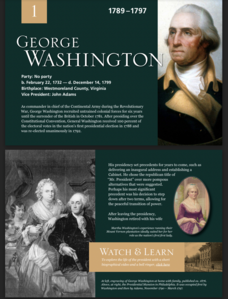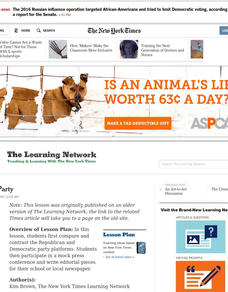Constitutional Rights Foundation
The Lincoln-Douglas Debates — Springboard to the White House
The Lincoln-Douglas Debates saw two primary political candidates debating seven different times about one of the most important social movements in United States history. Middle and high schoolers read an article that describes the...
Carolina K-12
Are You a Democrat or a Republican? Are You Really?
Have new or soon-to-be voters examine different political parties and their platforms as they figure out which one aligns most with their beliefs. After taking a few online quizzes, students split into pairs to discuss and then...
Carolina K-12
Political Parties and Conventions
The two major parties polarize many in America today, but it doesn't have to be that way in the classroom! Teach learners about political party platforms and modern campaigns with a mock political convention. After watching a PowerPoint...
Center for History Education
African Americans and the Democratic Party
Why did African American voters switch from the Republican Party to the Democratic party during the Depression Era? That is the question young historians attempt to answer as they study primary source documents from the period. The focus...
National Woman's History Museum
Fannie Lou Hamer and Social Activism
Not all heroes wear capes. An impactful lesson focuses on the life and activism of Fannie Lou Hamer during the civil rights movement. Scholars read her speeches and other material, participate in group discussion, and complete a jigsaw...
C-SPAN
Virtual Presidents Exhibit
Scholars get a glimpse into the lives of all 46 Unites States presidents. An engaging timeline details each president's background and time in office. LInks send pupils to a website with more in-depth information.
Constitutional Rights Foundation
Elections, Money, and the First Amendment
Those who spend the most, win. Academics read informational text, participate in group discussion, and defend campaign reforms to understand the correlation between money, the First Amendment, and election results. The resource...
Constitutional Rights Foundation
The Election of 1912
The Election of 1912: an election with four competitive opponents. Pupils get to know the candidates with informative reading passages that provide context to the election. Then, the class engages in a debate and answers questions as one...
Savvas Learning
Political Parties
What is a political party, and what major parties exist in American politics today? How did the party system develop in American history, and how are parties organized? These questions and many other details regarding the political party...
Curated OER
Development of American Political Parties: The Two-Party System
Was American politics always bound to the two-party system? Learn how the two-party system developed, why third parties tend not to do so well, and all the various political parties that have emerged throughout US history. Each party is...
Curated OER
Cartoons for the Classroom
Political cartoons have been used to decades. What do they symbolize? Why use a political cartoon instead of an editorial piece? Look at the two political cartoons illustrated here and analyze them as a class or in pairs. Consider...
Curated OER
Cartoons for the Classroom: 2012 Mid-Term Elections
Use a political cartoon to help scholars grasp the significant turnover in Congress following the 2012 mid-term election. A Mike Keefe cartoon uses symbols and current political lingo to convey perspective on the issue, and background...
Curated OER
Cartoons in the Classroom: Party Animals
In this current events activity, students analyze political cartoons that feature donkeys and elephants as political party symbols and respond to 2 short answer questions.
Curated OER
All Aboard The Campaign Train!
Learners explore campaign politics. In this political campaign lesson, students investigate multimedia sources in order to examine the structure of political parties and platforms from previous presidential elections. Learners then...
Curated OER
The Election Process
In this election process worksheet, middle schoolers learn about the election process in the United States in which the president is selected. They then answer the 16 questions on the worksheet. The answers are on the last page.
Curated OER
The Declaration of Independence
Students identify and examine the Declaration of Independence and ascertain its true intent and its eventual realization. Then they analyze the Declaration of Independence and summarize the intentions of the Declaration. Students also...
Curated OER
The Free Trade Conundrum: Balancing Worker Wages and Consumer Prices Comparing the 19th and 21st Centuries
By examining free trade, protectionism, and analyzing 19th and 21st century arguments for and against the tariff, students will be able to compare and contrast the 19th and 21st century. They will analyze text, answer discussion...
Curated OER
It's My Party
Students compare/contrast the Republican and Democratic platforms using Venn diagrams, then read and discuss, "The Conventions Are Over. The Party's Just Starting." students then participate in a mock press conference and write editorial...
Curated OER
Political Parties Questions
In this political parties activity, students respond to 14 short answer questions about the history of party politics in the United States.
Curated OER
Do Factions Control Political Parties Today?
Pupils establish how the first political parties were formed. In this U.S. History instructional activity, students work in groups to share their personal viewpoint on various topics provided by the teacher, then they are assigned...
Curated OER
The Solid South Switcharoo
Students examine primary sources. In this lesson on political parties, students view historic documents, speeches, and photos to trace the rise and fall of particular political parties. Students will be looking at the success of each...
Curated OER
Democrat: Print and Color
In this word recognition worksheet, students trace the word "democrat", write the word independently, and color the picture of a donkey.
Curated OER
President Ronald Reagan
In this President Ronald Reagan worksheet, students read a 2 page article on the President and then answer 6 questions with multiple choice answers.
Curated OER
Making Conventions Unconventional
Students discover how Internet altered the public's involvement in the 2000 Democratic and Republican conventions, and synthesize their evaluations of convention sites to design their own pages for a convention-related Web site.

























